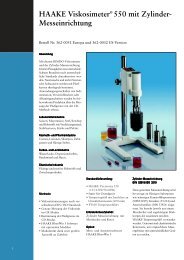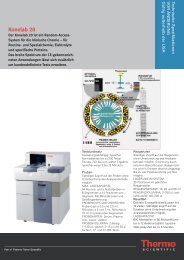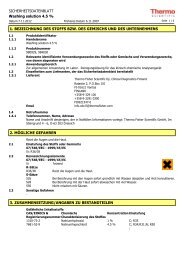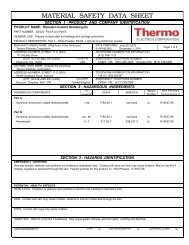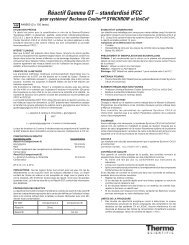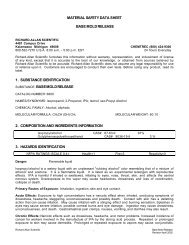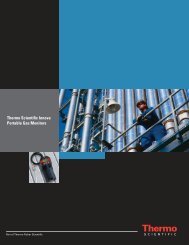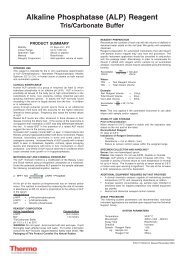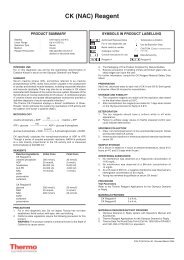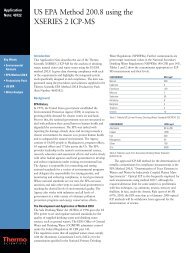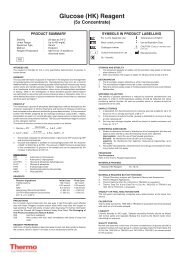Albumin Reagent
Albumin Reagent
Albumin Reagent
You also want an ePaper? Increase the reach of your titles
YUMPU automatically turns print PDFs into web optimized ePapers that Google loves.
<strong>Albumin</strong> <strong>Reagent</strong><br />
INTENDED USE<br />
For in vitro diagnostic use and for the quantitative determination of<br />
<strong>Albumin</strong> in serum on the Olympus Demand ® and Reply ® .<br />
SUMMARY<br />
Serum albumin levels have been determined by a variety of methods<br />
including salt fractionation, electrophoresis, immunochemical<br />
techniques and measurement of albumin directly, by virtue of the<br />
tendency of albumin to bind certain dyes such as bromocresol<br />
green, methyl orange, and HABA dye.<br />
The Thermo <strong>Albumin</strong> Procedure is a dye-binding method based on<br />
the original work of Rodkey 1 as modified by Doumas, et. al. 2 The<br />
addition of albumin to solutions of certain dyes results in the<br />
formation of a dye-binding complex that exhibits optical properties<br />
different from that of the free dye. The bromocresol green reaction<br />
is recognized as being more specific and reproducible than the<br />
other dyes for the determination of serum albumin. 1,3<br />
METHODOLOGY<br />
albumin + bromocresol green →<br />
green chromogen<br />
The Thermo <strong>Albumin</strong> Procedure is based on the dye-binding<br />
capabilities of serum albumin. <strong>Albumin</strong> reacts with bromocresol<br />
green at pH 4.2 to form a green color. The increase in color is<br />
measured bichromatically at 600/800 nm and is proportional to the<br />
amount of albumin present.<br />
REAGENTS<br />
Reactive Ingredients Initial Conc. Final Conc.<br />
bromocresol green 1.24 mmol/L 0.25 mmol/L<br />
sodium azide<br />
surfactant<br />
buffer<br />
PRECAUTIONS<br />
1. For in vitro diagnostic use.<br />
2. Do not ingest Toxicity has not been established. Avoid contact<br />
with eyes, skin and clothing.<br />
3. Contains sodium azide. Sodium azide may react with lead joints<br />
in copper drain lines to form explosive compounds. Drains<br />
should be well flushed with water when discarding the reagent<br />
PREPARATION<br />
<strong>Albumin</strong> <strong>Reagent</strong> is ready to use as supplied.<br />
STORAGE AND STABILITY<br />
1. The unopened reagent is stable until the expiration date stated<br />
on the label when stored at 2° - 30°C.<br />
2. After opening, the reagent is stable for 21 days when stored on<br />
the Olympus Demand or Reply at 2° - 8°C.<br />
DETERIORATION<br />
1. The reagent should be a clear yellow-green solution. Presence<br />
of turbidity or a precipitate could indicate deterioration and the<br />
reagent should not be used.<br />
2. Failure to achieve assay values on freshly prepared control<br />
sera could indicate deterioration.<br />
SPECIMEN COLLECTION<br />
Serum is the recommended sample. 4<br />
SAMPLE STORAGE<br />
<strong>Albumin</strong> in serum is stable for up to one week at room temperature,<br />
approximately one month refrigerated, and longer when frozen. 5<br />
INTERFERING SUBSTANCES<br />
1. At an <strong>Albumin</strong> level of 3.3 g/dL, a positive interference was<br />
observed at a Triglyceride concentration of 1050 mg/dL.<br />
At an <strong>Albumin</strong> level of 4.9 g/dL, no interference was observed<br />
at a Triglyceride concentration of 1100 mg/dL.<br />
2. No interference was observed at a Bilirubin concentration of<br />
14 mg/dL.<br />
3. At an <strong>Albumin</strong> level of 3.3 g/dL, a positive interference was<br />
observed at a Hemoglobin concentration os 220 mg/dL.<br />
At an <strong>Albumin</strong> level of 5.8 g/dL, a negative interference was<br />
observed at a Hemoglobin concentration of 294 mg/dL.<br />
4. Young has reviewed drug effects on serum albumin levels. 6<br />
PROCEDURE<br />
Test Parameters<br />
Refer to the Thermo <strong>Reagent</strong> Applications for the Olympus Demand<br />
or Reply.<br />
MATERIALS PROVIDED<br />
<strong>Albumin</strong> <strong>Reagent</strong> 10 x 18 mL<br />
MATERIALS REQUIRED BUT NOT PROVIDED<br />
1. Olympus Demand or Reply System with Operator’s Manual<br />
and Accessories<br />
2. Thermo <strong>Reagent</strong> Applications for the Olympus Demand or<br />
Reply<br />
3. Thermo Data-Cal (Cat No. 1905-505 or TR43001) or equivalent<br />
4. Thermo Data-Trol N and Data-Trol A (Cat. No. 1902-050 or<br />
TR40001 and 1901-050 or TR41001) or equivalent<br />
STABILITY OF FINAL REACTION MIXTURE<br />
The instrument automatically computes every determination at<br />
the same time interval.<br />
CALIBRATION<br />
Thermo Data-Cal (Cat No. 1905-505 ot TR43001 ) or equivalent<br />
should be employed with each set of unknowns assayed.<br />
LINEARITY<br />
Linearity extends to 6.0 g/dL Samples exceeding linearity should<br />
be diluted with normal saline and repeated. Multiply the result by<br />
the dilution factor when calculating the unknown.<br />
QUALITY CONTROL<br />
Normal and abnormal control serum of known concentrations of<br />
albumin should be analyzed routinely with each group of unknown<br />
samples. Thermo’s Data-Trol N and Data-Trol A (Cat. No. 1902-<br />
050 or TR40001 and 1901-050 or TR41001) are recommended for<br />
this purpose.<br />
CALCULATION OF RESULTS<br />
Results, expressed in g/dL at 37°C, are automatically calculated.<br />
LIMITATIONS<br />
See Storage and Stability, Deterioration, Specimen Collection,<br />
Interfering Substances, Sample Storage, and Linearity sections<br />
for limitations to this procedure.<br />
P/N: PI362041.03 Revised December 2003
EXPECTED VALUES<br />
An observed range for albumin, derived from a study of 52<br />
asymptomatic adults in the Southwest USA, was found to be 4.4-<br />
5.6 g/dL A range of 3.5-5.5 g/dL has been reported in the literature. 4<br />
These ranges should serve only as guidelines. Each laboratory<br />
should establish its own range of expected values, since differences<br />
exist between laboratories and local populations.<br />
PERFORMANCE CHARACTERISTICS<br />
Precision<br />
WITHIN RUN Level 1 Level 2<br />
No. data points 40 40<br />
Mean g/dL 3.3 4.9<br />
SD 0.022 0.028<br />
CV% 0.7 0.6<br />
TOTAL Level 1 Level 2<br />
No. data points 40 40<br />
Mean g/dL 3.3 4.9<br />
SD 0.045 0.081<br />
CV% 1.4 1.6<br />
COMPARISON STUDIES<br />
A comparison of the Thermo <strong>Albumin</strong> reagent (y) with a<br />
commercial reagent of the same methodology (x) was<br />
performed on 50 human samples in a range of 3.2 - 6.3 g/dL. A<br />
correlation coefficient of 0.9876 was obtained; the linear<br />
regression equation was y = 0.885 x + 0.131.<br />
SENSITIVITY<br />
Based on an instrument resolution of A= 0.001, this Thermo <strong>Albumin</strong><br />
Procedure has a sensitivity of 0.01 g/dL.<br />
REFERENCES<br />
1. Rodkey, F.L., Clin. Chem. 2, 1965, p. 478.<br />
2. Doumas, B.T., Watson, W.A., Biggs, H.G., Clin. Chim. Acta, 31,<br />
1971, p. 87-96.<br />
3. Beng, C.G. and Lim, K.L, Am. J. Clin. Path. 59, 1973, p. 14.<br />
4. Tietz, N. W., Textbook of Clinical Chemistry, W. B. Saunders<br />
Co., Philadelphia, 1986, p. 588.<br />
5. Doumas, B.T. and Biggs, H.G., Standard Methods of Clinical<br />
Chemistry, Academic Press, N.Y., 1976, p. 175.<br />
6. Young, D.S., Effects of Drugs on Clinical Laboratory Tests, 3rd<br />
ed., AACC Press, Washington, D.C, 1990, p. 3 - 12 -<br />
3-16.<br />
© 2003 Thermo Electron Corporation. All rights reserved. ® Olympus Demand and Reply<br />
are registered trademarks of Olympus Corporation, Lake Success, NY. All other<br />
trademarks are the property of Thermo Electron Corporation and its subsidiaries.<br />
Manufactured by:<br />
USA Contact:<br />
Thermo Electron<br />
Thermo Electron<br />
189-199 Browns Road, 331 South 104th Street<br />
Noble Park, Victoria, 3174 Louisville, CO, 80027<br />
AUSTRALIA<br />
U.S.A.<br />
Phone: (03) 9790 4100 Phone: (800) 558 9115<br />
Fax: (03) 9790 4155 Fax: (303) 581 6429<br />
Email: sales.clinicalchemistry@thermo.com<br />
www.thermo.com/clinicalchemistry<br />
Reorder Information and Technical Support<br />
Catalogue No.<br />
Configuration<br />
7200-002 10 x 18 mL<br />
Australia International U.S.A<br />
Phone 1800 333 110 61 3 9790 4100 (800) 558 9115<br />
Facsimile (03) 9790 4155 61 3 9790 4155 (303) 581 6429<br />
P/N: PI362041.03 Revised December 2003



